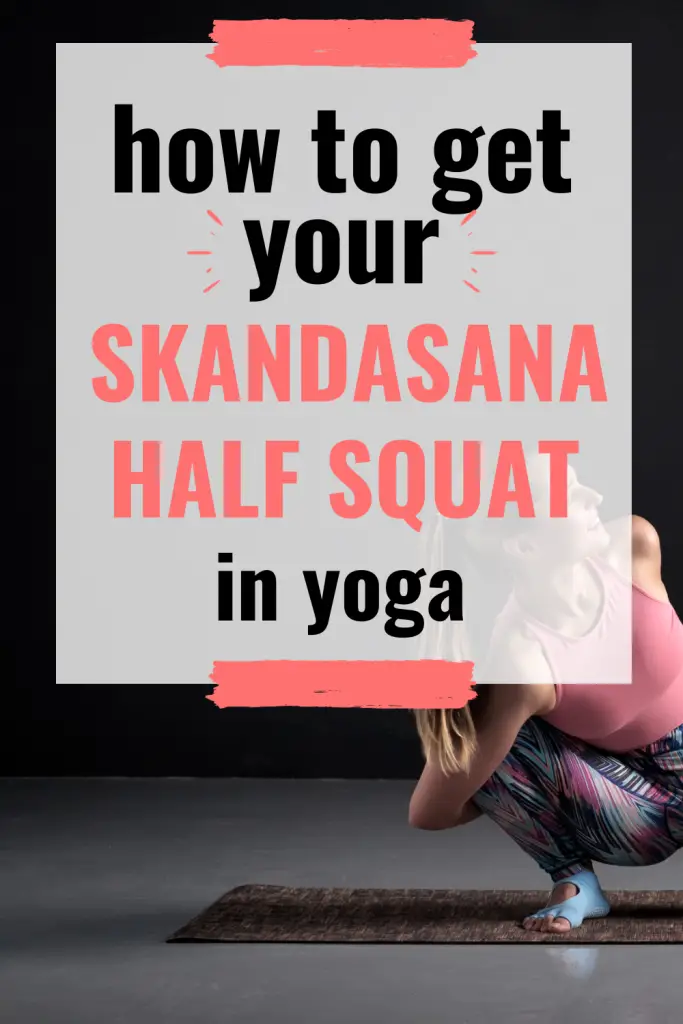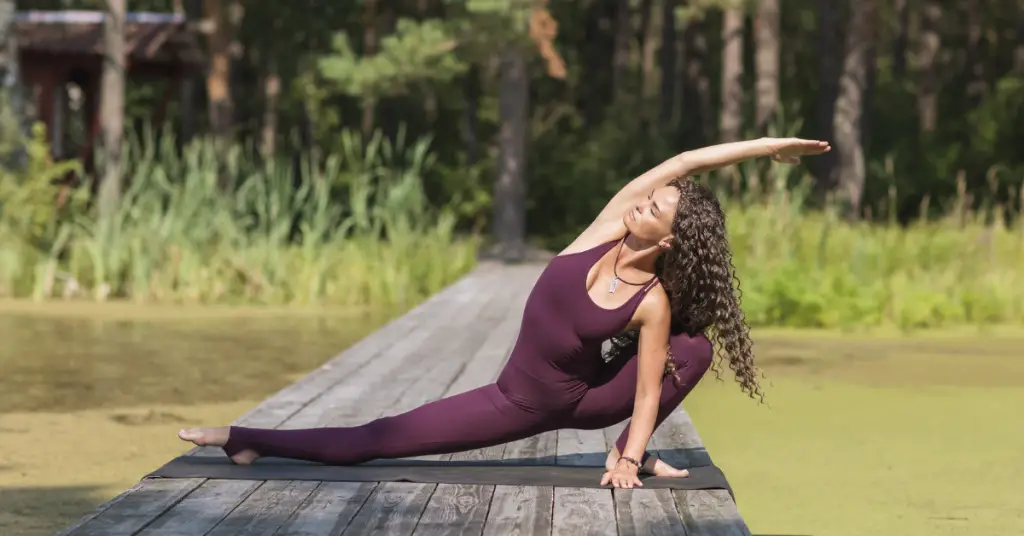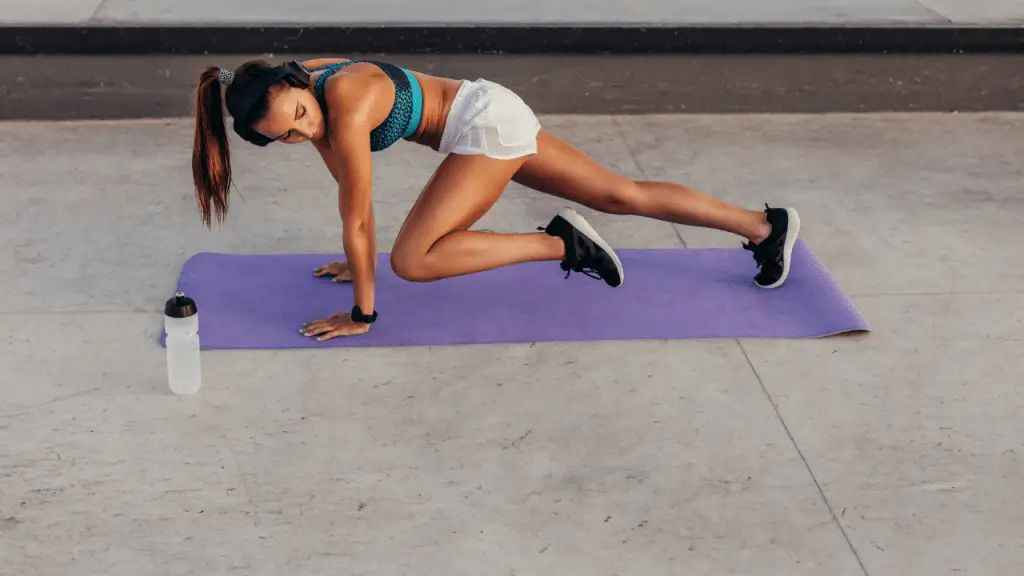Today’s Skandasana progression is perfect for those who want to gain the hip mobility necessary for this highly beneficial yoga pose. The side lunge is sometimes called half squat, or Skandasana (the Sanskrit name) is my favorite yoga pose for hip strength and flexibility.
Skandasana Yoga Pose for Beginners
The skandasana yoga pose may be too tricky for beginners who lack hip flexibility, strength, and ankle mobility. That’s where my skandasana progression comes in. Follow my full-length routine for targeted hip opening exercises you can practice regularly to get in your half squat. Plus, my skandasana progression tips will improve your practice over time.

Skandasana Progression Tips
These skandasana modifications may be just what you need to practice the pose when you thought you couldn’t do it:
- Stay higher in your side lunge: If you can’t sustain the half squat, you can stay higher in your lunge. Get as deep as you can, and you will increase the depth of your squat as you build your hip flexibility and strength.
- Bend your extended leg: When you lower your side lunge, you must ensure you do not lose the activation in your legs. I imagine you are sucking the energy from the earth into your pelvis with your legs. You are pressing the heel of your extended leg down on the mat and bending your knee slightly to keep this activation. Shortening your stance and bending your knee more is helpful in your skandasana progression.
- Use your hands for support: When moving from side to side, or even as you stay in your side lunge, you can support yourself if you need help to stay in the pose.
- Keep some momentum: The longer you stay in your side lunge, the harder it will be to get back up. As a beginner, it is a helpful progression to move faster from side to side to benefit from the momentum in your movements.
Focus on increasing your hip flexibility and strength as you practice your skandasana progression. You may enjoy the following routines: Yoga for Hip Strength and Flexibility (2 Video Routines), and How to Increase Hip Mobility: Try These Drills!.
Above all, you must remain consistent. If you need help establishing habits to support your yoga goals, you will enjoy my 5-Day Yoga Habit Challenge.
Skandasana Heel Up or Down
If your ankle mobility prevents you from lowering into the pose, you can keep your heels up in your yoga side lunge. More important than whether your heels are up or down is to ensure that your chest is nice and open (don’t crouch into the squat). Keep your butt buoyant by pressing the heel of the extended leg on the mat (you should be able to lift and lower your butt with the strength of your legs (shorten your stance if that helps).

Skandasana Progression Video
In today’s routine, we will start with some gradual hip opening and strengthening poses so that you can practice according to your level. If you can’t get into your half squat yet, focus on the exercises at the beginning of the routine (including your high-side lunge). Repeat the routine until you feel confident you can achieve the pose correctly.
Preparing for Skandasana, also known as the Side Lunge Pose, requires strength, flexibility, and balance. Skandasana is a deep, hip-opening pose that requires a certain level of readiness in various body areas. To achieve this, incorporating specific poses into your yoga practice can be highly beneficial. This article will explore six poses that can help prepare you for Skandasana: Boat Pose, Half Happy Baby Pose, Yogi Squat, Wide-Legged Forward Fold, Goddess Pose, Humble Warrior, and Lizard Pose.
- Boat Pose (Navasana): Boat Pose is an excellent core-strengthening pose that engages the abdominal muscles, hip flexors, and lower back. To perform Boat Pose, sit on the mat with your legs extended in front of you. Then, bend your knees and lift your feet off the floor, balancing on your sitting bones. Keep your chest lifted and lengthen your spine. For added challenge, try extending your legs straight while maintaining balance. This pose builds the core strength necessary to stabilize your body in Skandasana.
- Half Happy Baby Pose (Ardha Ananda Balasana): Half Happy Baby Pose stretches and opens the hips, preparing them for the demands of Skandasana. To do this pose, lie on your back and draw one knee towards your chest. Hold the outside of the foot with your hand, keeping your knee bent at a 90-degree angle. Gently press the knee towards the armpit as you maintain a relaxed breath. Repeat on the other side. This hip stretch helps to increase the range of motion in your hips, making it easier to move into Skandasana.
- Yogi Squat (Malasana): Yogi Squat is a deep hip-opening and strengthening pose that mimics the position of Skandasana. To perform Yogi Squat, stand with your feet wider than hip-width apart and turn your toes slightly outward. Lower your body into a squat position, bringing your hands together at your heart center. Keep your spine long, and use your elbows to press your knees outward gently. This pose helps to build strength in the inner thighs and hips while improving flexibility in the groin and hip joints.
- Wide-Legged Forward Fold (Prasarita Padottanasana): Wide-Legged Forward Fold is an excellent pose for stretching the inner and outer thighs, hamstrings, and groins. To practice this pose, stand with your feet wide apart, facing forward. Inhale, lift your chest, and hinge at your hips to fold forward as you exhale. Keep your spine long, bring your hands to the mat, or use yoga blocks for support. Wide-Legged Forward Fold increases flexibility in the hips and legs, which is crucial for Skandasana.
- Goddess Pose: The Goddess Pose, also known as Utkata Konasana in yoga, involves standing with feet wide apart, toes pointing slightly outward, and bending the knees to bring thighs parallel to the ground. The arms are extended outwards at shoulder height, creating a strong and empowered stance resembling a divine goddess.
- Humble Warrior (Baddha Virabhadrasana): Humble Warrior is a variation of the traditional Warrior Pose that provides a deep stretch to the hips and thighs. To perform this pose, start in Warrior I pose, with your right foot forward and left back. Interlace your hands behind your back, and fold your torso inside your right leg as you exhale. Keep your back leg straight and strong. Humble Warrior stretches and opens the hip flexors and groin, preparing your body for the lateral movements required in Skandasana.
- Lizard Pose (Utthan Pristhasana): Lizard Pose is a fantastic hip opener targeting hip flexors, hamstrings, and quadriceps. Begin in a plank position, then move your right foot outside your right hand. Lower your left knee to the ground, and untuck your toes. As you inhale, lift your chest and lengthen your spine. You can lower your forearms to the ground or use yoga blocks for a deeper stretch. Lizard Pose helps to release hip tension and improve flexibility, which is crucial for Skandasana.
In conclusion, preparing for Skandasana involves working on core strength, hip flexibility, and balance. Incorporating poses like Boat Pose, Half Happy Baby Pose, Yogi Squat, Wide-Legged Forward Fold, Humble Warrior, and Lizard Pose into your regular yoga practice can help you build the foundation for mastering Skandasana. Remember to practice these poses mindfully, listen to your body, and gradually progress at your own pace. With consistent effort and dedication, you will gradually enhance your ability to move into Skandasana gracefully.
Keep scrolling for the full-length routine!
Skandasana Benefits
Skandasana, also known as Side Lunge Pose, is a powerful yoga asana that offers many physical and mental benefits. This pose involves deep hip opening and lateral movement, making it an excellent addition to any yoga practice. Here are some of the key benefits of Skandasana:
- Hip Flexor and Groin Stretch: Skandasana is a deep hip opener that stretches the hip flexors and groin muscles. Regular practice of this pose can help release tension and tightness in the hips, making it beneficial for people who spend long hours sitting or have tight hip muscles.
- Inner Thigh and Adductor Strengthening: As you move into the side lunge position, your inner thigh muscles (adductors) must engage to support the body’s weight. This strengthens the inner thigh muscles and helps improve stability in the hips.
- Balance and Stability: Skandasana requires a good sense of balance and stability as you move from side to side. Practicing this pose helps to enhance your proprioception and improves your ability to maintain balance in various yoga poses and daily activities.
- Flexibility in Hamstrings and Quadriceps: The extended leg in Skandasana experiences a deep stretch in the hamstring muscles, while the bent leg experiences a stretch in the quadriceps. This combination of stretching the front and back of the thighs helps to increase overall leg flexibility.
- Core Engagement: To maintain proper alignment and balance in Skandasana, you must engage your core muscles. Regular practice of this pose helps strengthen and tone the abdominal muscles.
- Stimulates Manipura Chakra: In yoga, the Manipura Chakra, also known as the Solar Plexus Chakra, is associated with personal power, self-confidence, and transformation. The lateral movement and deep hip opening in Skandasana activate and balance the Manipura Chakra, promoting self-assurance and empowerment.
- Emotional Release: Hip-opening poses like Skandasana are believed to be associated with releasing stored emotions and tension. Many practitioners experience emotional release or relief after practicing this pose.
- Blood Circulation: The deep hip opening and stretching involved in Skandasana increase blood flow to the pelvic region, which can benefit reproductive health and digestion.
- Preparation for Seated Poses: Skandasana is an excellent preparatory pose for other seated poses, especially those that require open hips and flexibility, such as Lotus Pose (Padmasana) or Bound Angle Pose (Baddha Konasana).
- Mindfulness and Focus: Holding and transitioning through Skandasana require concentration and mindfulness. Practicing this pose can help cultivate a focused mind and a deeper connection with your body and breath.
As with any yoga pose, it’s essential to approach Skandasana mindfully and with proper alignment. If you are a beginner or have any pre-existing medical conditions or injuries, it’s advisable to practice under the guidance of a qualified yoga instructor. They can offer modifications and adjustments to ensure you gain the maximum benefits while avoiding potential risks.
Skandasana is a transformative pose that enhances physical strength and flexibility and promotes mental clarity and emotional well-being. Incorporating this pose into your yoga practice can create a balanced, open, harmonious body and mind.
Skandasana Progression: Full-Length Routine
This skandasana progression routine is meant to use to build your side lunge. It includes flexibility and mobility exercises that you can repeat to get a stronger yoga side lunge.





